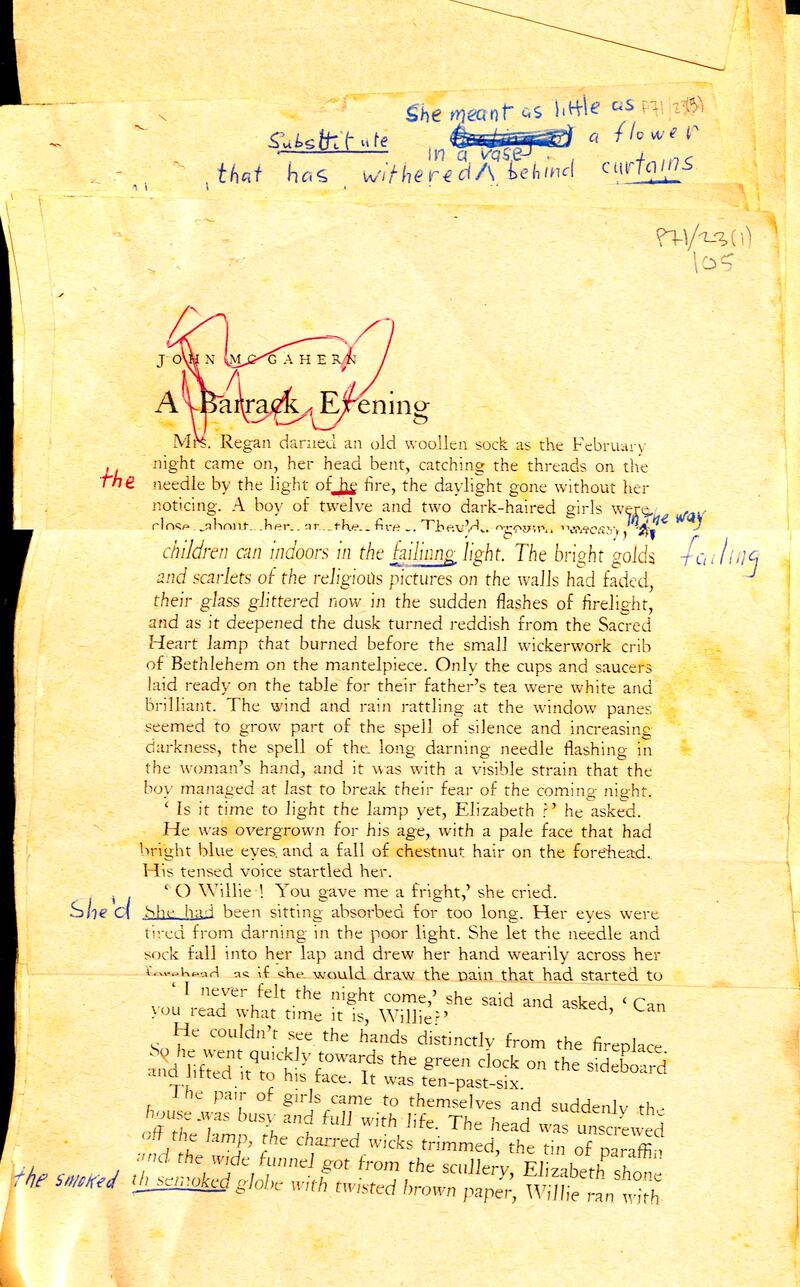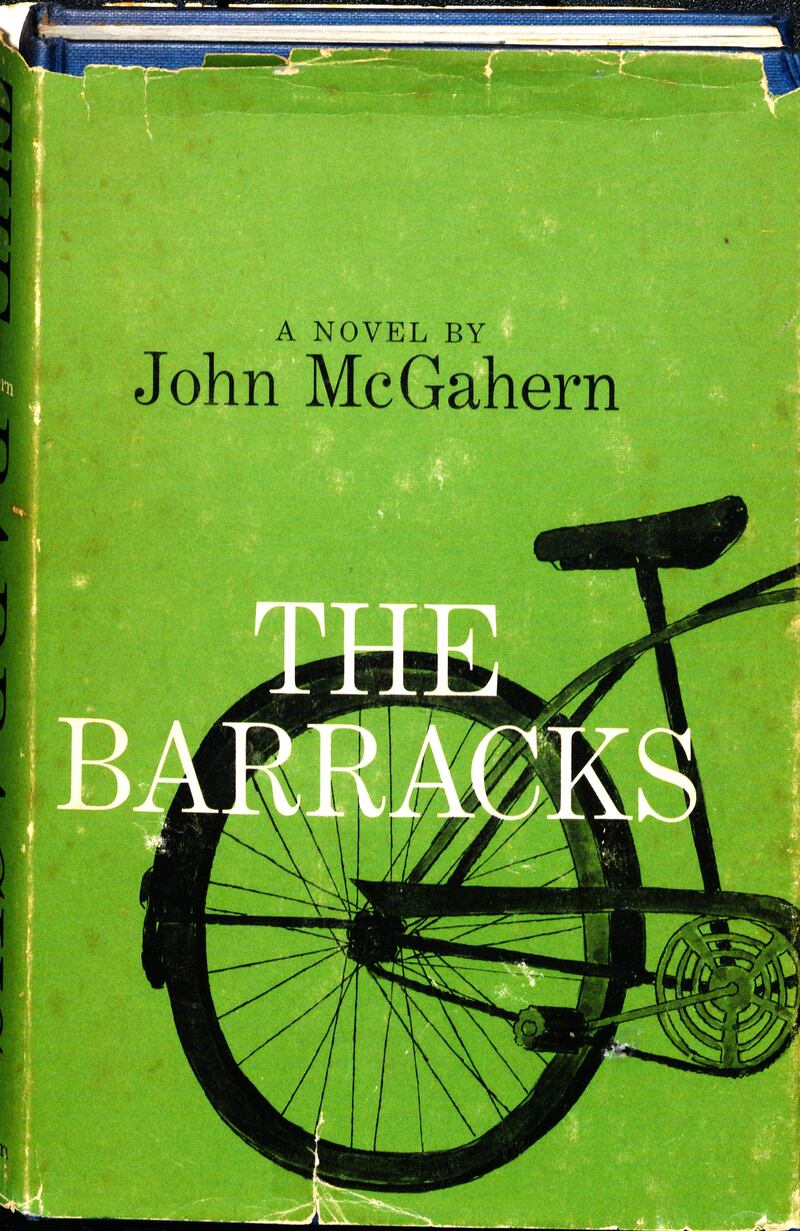In April 1963, the second-biggest selling novel in Ireland was Ian Fleming’s On Her Majesty’s Secret Service. The James Bond story was kept off the top spot by a debut novel from a new Irish writer – The Barracks by John McGahern. Published 60 years ago this year, The Barracks confirmed McGahern’s arrival, as well as critical and public success, as a writer.
The novel stands as a carefully crafted account of the tensions of power and love, the frailty of the body and mind, as well as the tedium of routine in service of both the State and the family in rural mid-20th century Ireland.
Elizabeth Reegan, one of McGahern’s most enduring characters, is slowly dying from the beginning, even before her cancer diagnosis: “Mrs Reegan darned an old woollen sock as the February night came on, her head bent, catching the threads on the needle by the light of the fire, the daylight gone without her noticing”.

Her husband, the widowed and impetuous Reegan, is the sergeant of a rural district in which patrols become phoney wars with absent crime and endless entries in police ledgers. The novel explores the existential quandary around the presence and absence of life, spirituality, intimacy and family relationships. The natural world, the passing of seasons, of time, of memory, are all transient elements in the book, as Elizabeth seeks an answer to her lingering question: “What was her life?”
With car prices surging, where can budget-conscious drivers turn? The answer may surprise you
The Music Quiz: Which Britpopper on Top of the Pops opened his jacket to reveal a taped sign reading ‘I hate Wet Wet Wet’?
Two tiny captives, symbols of hostage crisis, to come home dead, Hamas says
‘They’re supposed to represent us, not sue us’: Crafts council threatens members after critical feedback
The John McGahern archive at University of Galway Library contains numerous manuscript drafts, annotated typescripts, correspondence and contracts about the book’s publication, as well as numerous international first editions. The painstaking process, shaping words, phrases, characters, and places, are documented within the various drafts. An offprint of A Barrack Evening, one such early draft, shows McGahern taking care to revise one single image, that of withered flowers found in a vase on a spring morning, forgotten about since the previous winter in a startling account of recollection by Elizabeth of her own mother’s funeral.
A 1983 paperback edition of the book was used by McGahern for many of his public readings. In it are scores of annotations with lines, phrases and entire paragraphs crossed out, a practice McGahern often did with his own editions, tinkering with his words long after they are first published.
The poet John Montague closely read drafts of the novel in development. Writing from Paris in April 1963, Montague wrote “I have been meaning to write to you about The Barracks, which seemed to me an extraordinary book.” Montague adds that: “Time and time again I was overwhelmed by the beauty and exactness of the writing … I wish I could write prose with that ease and effortless detail”.
Such exactness and sparing prose would prove a challenge for translators, including Elizabeth Schnack who translated much of McGahern’s work into German. When working on a translation of The Barracks, she revealed that she laboured over one sentence for three hours. When published in German in 1978, the title of The Barracks translated as The Police Kitchen or The Man Goes Out Like a Light.

The subtitle, Schnack explained, was a quotation from the novel. The revised title is a subtle but significant change in tone and meaning. It reiterates the blurring of spaces within the book and between the public and the private in Irish society. The Barracks is of course a workplace for the police force of the Irish State but it also doubles as the domestic and family world in which Elizabeth and Reegan live in with the children, but yet where they are both so utterly separate from each other, emotionally and physically.
As Tom Inglis has noted, “What McGahern reminds us an understanding of the emotional upheavals that came with the decline of the traditional Irish Catholic self.” This slow untangling of that other trinity in Irish society: family, church, and State, which remained such a central focus through many of McGahern’s later novels and short fiction, is clearly present here.
The family unit was perceived as the cornerstone of the new Irish Republic, a representation of de Valera’s Ireland, one in which the household, for many women like Elizabeth, became less a home or even a barracks, but a cell in which they were confined, physically, emotionally, economically, and constitutionally.
For various reasons, Elizabeth’s parents opposed her marriage to Reegan. “Himself can be no angel either”, they remind her. Elizabeth would be lost as a carer for her own ageing mother, but also risked stigma for her family: “There’s three childer and his wife is barely cauld in the grave, remember… Marryin’ isn’t something, believe me, that can be jumped into today and outa tomorrow.”

In The Third Policeman, Flann O’Brien may have asked “Is it about a bicycle?” but Ellen Raskin’s book jacket design for the 1964 first American edition of The Barracks might have pushed readers to ask the same question. The design features the sole image of a bicycle wheel, gears, cogs, saddle and pedals. These mechanics and parts of the bicycle are part of McGahern’s detailed depiction of the daily, aimless, and absurdly endless ‘patrols of the imagination’ undertaken by Reegan and his team. Not unlike O’Brien, McGahern links the movement and human form of his characters as being almost part of the mechanics of the bicycle. For instance:
“It was their father’s tyres they first heard going past on the loose gravel and, ‘Daddy’s home’, they said to Elizabeth. His black cycling cape and pull ups were shiny when wet when he came, his face chafed with wind and rain… a terrible night to have to cycle about like a fool.”
Reegan is working in the bog as Elizabeth dies, consumed in his excavation of the wet peat in an act of all-consuming escape away from duties as both Guard and husband. In a document in the archive, McGahern makes a Beckettian conclusion, describing Elizabeth as someone who “experiences the beauty of things about her with increasing violence”.
Today, the building of the Barracks in Cootehall has been completely refurbished and is run by local volunteers. It stands not only as a museum of John McGahern but of gardaí and policing in rural Ireland. Open to the public, the Barracks Museum offers a tangible link to McGahern’s novel, and of his own life, sixty years after the publication of The Barracks. The museum is a fitting legacy to the book that bears the name of the place that left such an indelible imprint on McGahern’s life.
At various points in the novel, memories of Elizabeth’s former lover, a young doctor called Halliday, intrude into her solitude in the present. Killed in a car accident, Halliday’s spectral presence is carried forward by Elizabeth, as Greta Conway similarly carried the love and memory of her young dead lover, Michael Furey in James Joyce’s The Dead. “What the hell is all this living and dying about anyway, Elizabeth?” Halliday asks. Perhaps the greatest achievement of The Barracks and of McGahern’s writing, is a journeying towards an answer of this impossible question.
A special webinar discussion marking 60 years of The Barracks will take place online, on March 20th, at 7pm, with Colm Tóibín, Catriona Crowe and Niamh Campbell, chaired by Tom Inglis and Barry Houlihan. Details: mcgahernbarracks.ie













